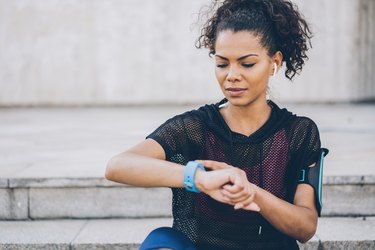
Your heart rate highlights how hard your body works during any activity, including exercise. Even if you're not an athlete, your heart rate is still important and can be an indicator for abnormal or underlying health conditions. Here's what to know about your heart rate and exercise.
Video of the Day
Video of the Day
Your Heart Rate Baseline
"Heart rate is a very helpful tool to help guide exercise intensity and provide insight into how training is going," says Philadelphia-based Neel Chokshi, MD, MBA, cardiologist, medical director of the Sports Cardiology and Fitness Program and associate professor at Penn Medicine.
"But," he says, "be cautious not to obsess about heart rates. It's meant to provide data and insight, not angst."
Keep in mind that your heart rate doesn't just depend on your fitness level, according to the American Heart Association (AHA), and it will fluctuate depending on:
- Your age
- Emotional stressors
- Nutrition and hydration
- Sleep
- Medications
- Intensity of activity
So, when should you be concerned?
Heart Rate Red Flags
If your heart rate jumps too quickly when you exercise, it might be a sign that something is off, Dr. Chokshi says.
Very active people might notice their heart rate drops within 60 seconds of stopping physical activity. For someone who is less consistently active, it could take up to 10 minutes for your heart rate to drop, says Mark Estes, MD, cardiologist, program director of the Clinical Cardiac Electrophysiology Fellowship and visiting professor of medicine at the University of Pittsburgh Medical Center, Pittsburgh, Pennsylvania.
If you experience a high heart rate that lasts longer than 10 minutes, that might be an indicator that you should get checked out, Dr. Estes says.
How to Calculate Your Resting Heart Rate
"Exercise has immense cardio benefits. It makes you live longer and feel better, and lowers your blood pressure, blood sugar and lipids," Dr. Estes says. "And with exercise, it's really important to know your numbers."
In other words, know your average resting heart rate and target heart rate for exercise. According to the AHA, a normal resting heart rate should range between 60 and 100 beats per minute.
To measure, Dr. Estes says:
- Take your pulse on the inside of your wrist or on your carotid artery (your neck).
- Count the number of beats for 15 seconds.
- Multiply that number by four.
If your resting heart rate is high — above 100 beats per minute (bpm) — it might be a sign that you should seek medical attention, Dr. Chokshi says.
Establishing a Goal Heart Rate During Exercise
Your heart rate will always go up during activity, but knowing your target heart rate for specific intensity levels will help your heart maintain a steady beat throughout your workout.
Per the AHA, you can estimate your maximum heart rate for physical activity by subtracting your age from 220. For example, if you are 35 years old, your average maximum heart rate would be 185.
Your target heart rate zone is a percentage of your maximum heart rate: "The target heart rate during moderate-intensity activities should be about 50 to 70 percent of maximum heart rate," says New York City-based Sam Setareh, MD, a cardiovascular disease fellow at Mount Sinai Health System, Icahn School of Medicine at Mount Sinai Morningside. That's about 93 to 130 bpm for that same 35-year-old, per the AHA.
"Your target heart rate during vigorous physical activity should be about 70 to 85 percent of maximum," Dr. Setareh says; 130 to 157 bpm for the 35-year-old. according to the AHA.
Tracking Your Heart Rate
You've likely seen (or might already own) a wrist or chest monitor that uses technology to measure your heart rate for you. But are they accurate?
"They are generally accurate at lower heart rate and activity levels, but when you get to higher activity levels, these monitors tend to be less reliable due to sweat and artifact," Dr. Chokshi says.
- American Heart Association: “All About Heart Rate (Pulse)”
- American Heart Association: “Target Heart Rates Chart”
- Neel Chokshi, MD, MBA, double board-certified cardiologist; medical director, Sports Cardiology and Fitness Program; Associate Professor of Clinical Medicine; Penn Medicine, Philadelphia, Pennsylvania
- Mark Estes, MD, FACC, FHRS, triple board-certified cardiologist; program director, Clinical Cardiac Electrophysiology Fellowship; visiting professor of medicine; University of Pittsburgh Medical Center, Pittsburgh, Pennsylvania